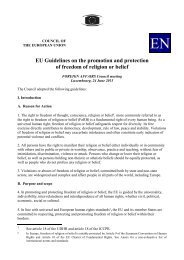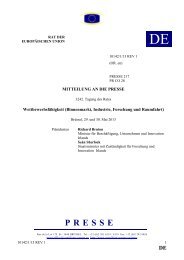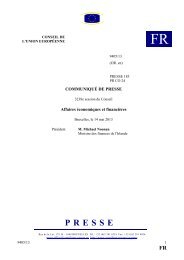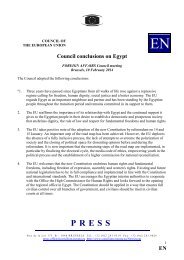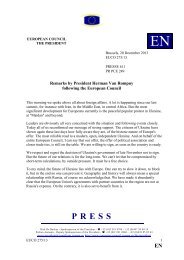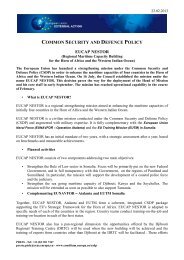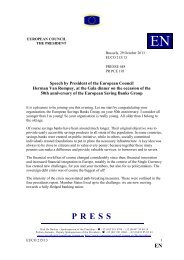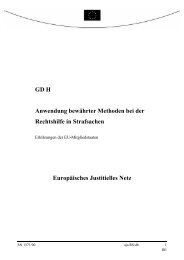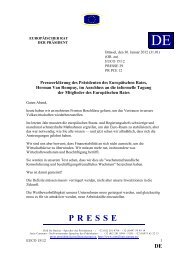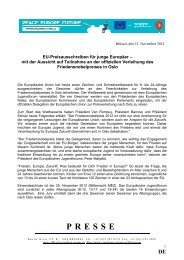14508/09 ADD 1 PL/vk 1 DG G COUNCIL OF THE ... - Europa
14508/09 ADD 1 PL/vk 1 DG G COUNCIL OF THE ... - Europa
14508/09 ADD 1 PL/vk 1 DG G COUNCIL OF THE ... - Europa
You also want an ePaper? Increase the reach of your titles
YUMPU automatically turns print PDFs into web optimized ePapers that Google loves.
Additionally if the household is seen as a collection of individuals, instead of as an entity, the<br />
possibility of different risks among its members becomes a possibility, especially if a time<br />
dimension is added to the risk. Women are less likely than men to secure a decent individual<br />
income through employment. Women have lower employment rates, a greater likelihood of<br />
interrupting their employment and working reduced hours to attend to family care responsibilities.<br />
They have lower pay and accumulate lower pension and other social benefits where eligibility is<br />
earnings-related or based on individual records of employment history. Gender inequalities produce<br />
a situation where women’s individual risk of poverty is much higher than men’s, especially if there<br />
is a divorce or if the other partner dies.<br />
The use of the at-risk-of-poverty rate of women versus men is partly inadequate due to the lack of<br />
regular data on women’s and men’s own earnings, their economic contribution, the distribution and<br />
control of income within households. Women’s poverty can only be revealed by looking within the<br />
household’s “black box”. These limits were underlined in the report by the Portuguese Presidency<br />
of the EU in 2007. Moreover, a positive sign will be the implementation of the first survey at EU<br />
level on “intra-household allocation of resources” in 2010 as a an-hoc module of the EU-SILC 23 .<br />
Indicator 2 is based on the same poverty measure as indicator 1, but here the categories are single<br />
parents, single women and single men without children. Data disaggregated by sex for single<br />
parents are not available.<br />
The data for indicator 3 are from Eurostat, EU-Labour Force Survey. The assumption behind the<br />
indicator is that being employed and receiving earnings are crucial for escaping poverty and<br />
economic dependence. Due to gender imbalances, the interruption of working life or inactivity for<br />
family care reasons can act as women-specific factors that may generate a loss of economic<br />
independence and, later in the lifecycle, a lower level of social protection (lower pensions). This<br />
indicator also sheds some light on the factors of poverty at an individual level inside the household,<br />
but is far from unproblematic.<br />
23 The list of variables has been adopted via Commission Regulation (EC) N° 646/20<strong>09</strong> of<br />
23 July 20<strong>09</strong>.<br />
<strong>14508</strong>/<strong>09</strong> <strong>ADD</strong> 1 <strong>PL</strong>/<strong>vk</strong> 50<br />
ANNEX <strong>DG</strong> G EN



